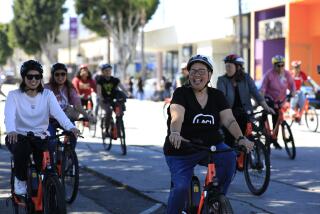E-bikes are a hit at Interbike show in Vegas
The big buzz at the annual Interbike show this month in Las Vegas was the e-bike: a bike with a stealthy electric motor hidden in the wheel hub or crankshaft that pedals like a normal bike but gives you a quiet boost when you want it. By clicking a handlebar button, you tell the motor how much or little “pedal-assist” you want. Die-hard cyclists called it sacrilege, but they’d better get used to it. E-bikes are already huge in Europe and exploding here. A 30-second ride explains why: The “e” is for exhilaration. E-bikes let couples ride together — as slow or fast as they want — at the same pace. They get college students to classes and commuters to work sweat-free. Best of all, they get everyone — young, old, skinny, fat, fit, non-fit — over the thing that stops most regular folks from cycling in the first place: the hills. In that sense, they are great starter bikes to shape up the out-of-shape … and might even lead them back to non-motorized bikes. Not cheap, but nearly free once you own one (no insurance is required since the electric assist cuts off at 20 mph), the e-bike eliminates all the negatives of cycling — and just leaves the fun.
Smooth moves
Haibike XDuro rx 29 mountain bike: The 10-speed, aluminum-framed, extra-large 29er hard-tail mountain bike from a German company includes a center-mounted 250-watt motor, which is unique in a market full of motors embedded in the hub of the rear wheel. The XDuro, like all others, is a pedal-assist, meaning that the motor shuts off if you are not pedaling or if you top 20 mph.
Likes: Smooth, powerful speed and striking looks. The pedal-motor interaction is instant and seamless — possibly a bit smoother than the rear-hub-motor bikes, although all the bikes worked fine. (Bosch claims that the hub motors are less efficient and have a slight lag between pedaling and the motor assist and that the crank-mount position allows its engine to be smaller yet more powerful.) Handling’s great due to the bike’s roll-over-anything 29er wheels and balanced weight distribution from the central locations of the frame-mounted battery and egg-shaped motor. (The same Bosch system is also found on bikes from Irvine-based Felt and Canada’s LaPierre.) The computer display includes odometer, trip distance, clock, speed, average speed and trip time. Data bars tell you how much human power versus motor power is being put into the system and evaluate how much range you have left, eliminating range anxiety. The push-button controls, next to the left grip, let you click through four power modes, from Eco to Turbo, the latter allowing the thrill of climbing a steep hill at 15 mph that would normally have reduced me to a grunting, zigzagging 1 mph.
Dislikes: The display, which is mounted over the stem, can be damaged in an end-over-end crash, as my son proved on his first ride on a steep dirt trail. Putting the display in a more shielded position might be a good idea.
Price: $4,000. (A Haibike full-suspension model goes for $5,200.) www.currietech.com
::
Add it to anything
BionX conversion kits: An add-on pedal-assist e-bike system from the Quebec-based company includes a rear-wheel motor (350 or 500 watt), frame- or rack-mounted battery and dashboard controls that can economically retrofit any regular bike with electric power. It adds about 17 pounds.
Likes: Works great. BionX has performed flawlessly for my son during his daily 7-mile school commutes and 30-mile recreational trips for the last nine months. Despite carrying a heavy backpack full of books, he arrives in class energized but sweat-free. The system has four levels of pedal-assist power and a battery-regeneration feature that adds a slight recharge during downhills and braking. Can be installed in a couple of hours. Ideal for commuting and for bikes that move heavy loads, like cargo bikes and tandems. (Complete BionX-equipped bikes are available from Trek, Smart ebikes, Xtracycle, OHM and Yuba.)
Dislikes: None
Price: $1,799 (350w motor); $2,499 (500w). www.ridebionx.com
::
Pure fun, with oomph
Pedego Interceptor: This seven-speed electric balloon-tire cruiser bike from an Irvine-based company has a step-through frame, swept-back handlebars, a wide cushioned suspension seat and a no-pedal throttle as well as conventional pedal assist, a compact rear hub motor and an integrated headlight and taillight. The model reviewed has optional extra-strength mag wheels ($400) for riders up to 400 pounds.
Likes: This is the feel-good bike. The forward-crank geometry and swept-back handlebars with faux leather grips put you in a comfy straight-back riding position. The matching fluorescent paint job and rims stopped traffic and made onlookers smile and wave. The power lets you fly. A twist-throttle, rare on pedal-assist bikes, overrides the five pedal assist modes to let you instantly gun it up a hill or give yourself a break from pedaling altogether. The modular display panel on the handlebars includes all the standard cycle computer information as well as a USB port for charging a cellphone. The standard 360 watt engine has an estimated 20-mile range at moderate power levels. Larger motors with longer ranges can run an additional $500. Pedego has a full line of bikes, including conventional commuters, a fat bike and a mountain bike.
Dislikes: None
Price: $2,895, $3,295 with mags. www.pedegoelectricbikes.com
::
Two-wheel Maserati
BESV Lion LX1: Standing for “beautiful, elegant, smart value,” this 10-speed aluminum-framed e-bike from a San Jose-based company has a hidden-in-the-frame battery, robust 500 watt rear-wheel motor, a “smart” mode with self-adjusting motor assistance, fenders, integrated lights and access to a number of Bluetooth-integrated cellphone apps, such as an anti-theft bike location beam.
Likes: Looks and performance. Even the cyclometer dashboard has a cool rounded design. Its four levels of power assistance are overridden temporarily by smart mode, which uses a torque sensor to switch automatically to more or less motor input as it detects how much effort you are making. So as you climb a hill, it gives you more power without your having to press a button and take a finger off the grip. Available for order now with deliver after Christmas.
Dislikes: None
Price: $5,000. www.besv.com
Wallack is coauthor of “Bike for Life: How to Ride to 100.” [email protected]
More to Read
Sign up for The Wild
We’ll help you find the best places to hike, bike and run, as well as the perfect silent spots for meditation and yoga.
You may occasionally receive promotional content from the Los Angeles Times.






